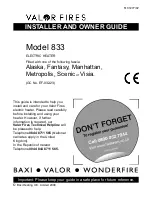
P·18
tely empty the rest of pressure in the cooker. If you need to open your cooker immediately after
closing the stove without waiting 3-4 minutes, hold the cooker under cold tap water for a minute
and completely empty the remaining pressure by turning the cooking valve button towards “steam
discharge.” Do not force open the lid. when the cooker is full with pressure. Be careful for steam
spurts while you are emptying the steam. You must be patient and careful. Never forget that your
cooker cooks with pressure. You will see that pressure cookers used in accordance with their ins-
tructions cause no danger whatsoever. Manage your time well to make delicious and tasty food.
Cleaning and Maintenance:
You can wash your pressure cooker’s pot and lid in the dishwasher.
Wash the gasket only by hand. Dry the pot, lid and gasket after washing. Cookers that are not dried
may have lime stains depending on your water’s characteristics. Place the lid as the text on the seal
surface facing the lid. Do not use abrasive substances of anything that may scratch your cooker. To
clean up stubborn stains, put in 2 cups of water and the juice of half a lemon and boil this mixture
under pressure for 5 minutes. Take it off the stove and wait for the pressure to lower, leave it to cool
and rinse with plenty of hot water.
How to clean the cooking valve assembly:
The cooking valve assembly must be cleaned
after each cooking process. Take up the lid, open the cooking valve assembly’s connection nut
under the lid by turning with your hand or coins. Separate the freed valve assembly from the lid of
the pressure cooker. Turn the valve assembly over and remove the seal. Make sure that the steam
escape channel on the valve assembly is not clogged. In case that the steam escape channel is
clogged, clean the channel with cotton swabs. Clean the food residues at the lower surface of the
valve assembly. Rinse the valve group and the steal with plenty of water and wait for them to dry.
After drying, place the steal in its housing in the valve assembly. Clean the connection nut of the
valve assembly and housing of valve assembly on the lid of the pressure cooker. Install the valve
assembly to the housing on the lid of the pressure cooker with connection nut.
If too much steam is coming out of the cooking valve while on cooking:
The stove might be too high. Lower the heat to a minimum.
The cooking valve may be dirty. After discharging the pressure in the cooker, take it off and wash it.
The cooking valve may be not working. Change it with a new one by contacting the manufacturing
company.
If the lid of the pressure cooker does not open:
If the pressure in the pot has not completely
been discharged, the safety lock is on. Wait a while longer and then try again.
If it cools down slowly, it may have vacuumed; turn the cooking valve all the way to steam discharge
and try to open the lid. Do not force-open the lid. The cooking valve may be blocked. Wait for your
cooker to cool down entirely.
If steam is coming out from between the pot and the lid:
Check that there is no problem
with the gasket of the lid. Place the gasket in the lid correctly. If pressure forms very slowly in the
cooker, the gasket may not hold the pressure. When the cooking valve is turned towards steam
discharge, gently press down on the lid with your hand. If there is still steam seeping out between
the lid and the pot, change the gasket with a new one obtained from the manufacturing company.
If no steam is discharging from the cooking valve:
The cooking valve may be blocked or
dirty. Cool down the cooker entirely and take off and clean the cooking valve in accordance with
the instructions. There may be no liquid in the pot; put it at least one cup of liquids. Check that the
gasket is not damaged.
If the lid does not close:
Place the gasket in the lid correctly. Place the lid as the text on the seal
surface facing the lid. Enable the clips to open completely on both sides.
Summary of Contents for LIFECOOK
Page 74: ...P 74 ...
















































